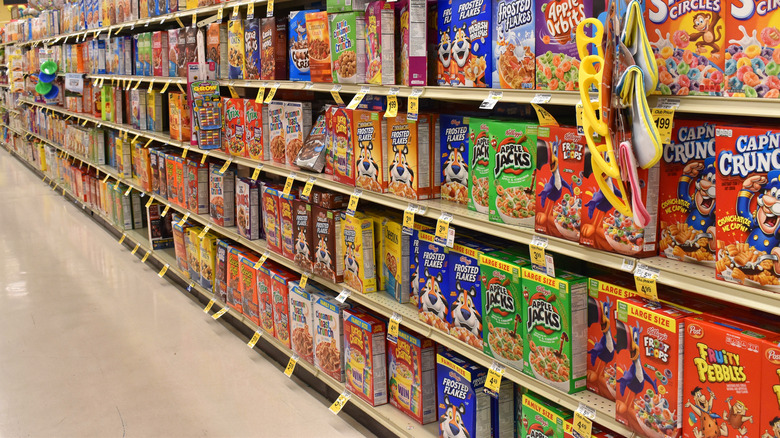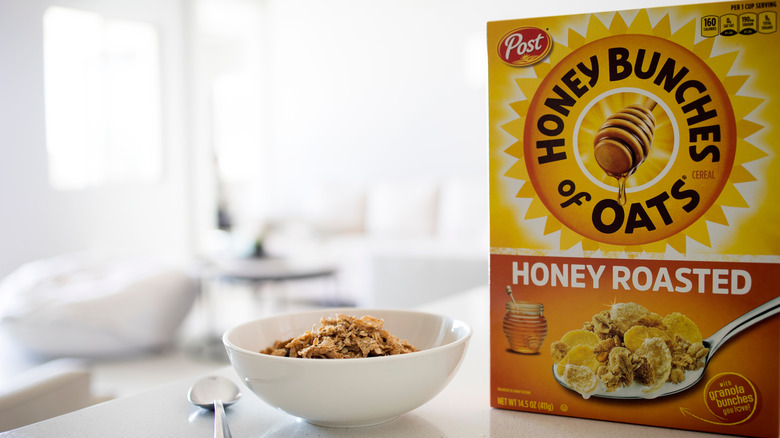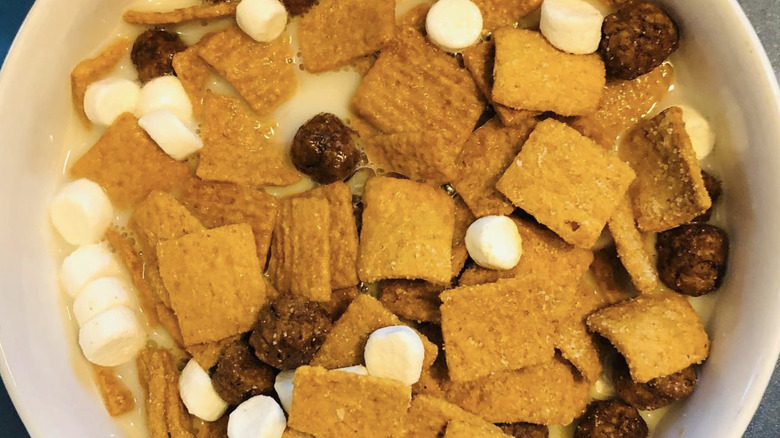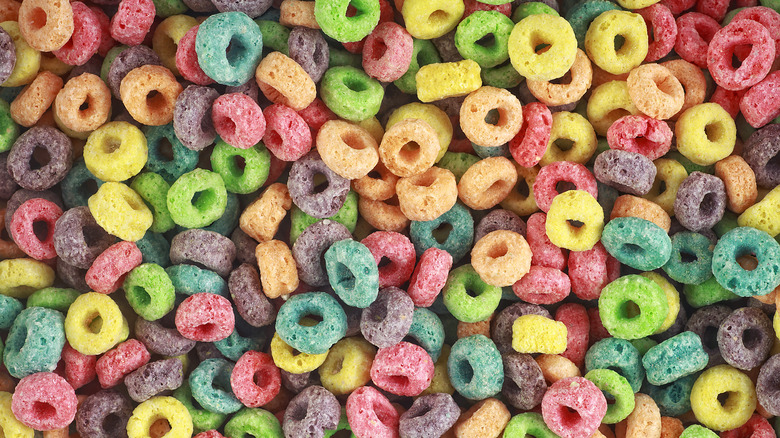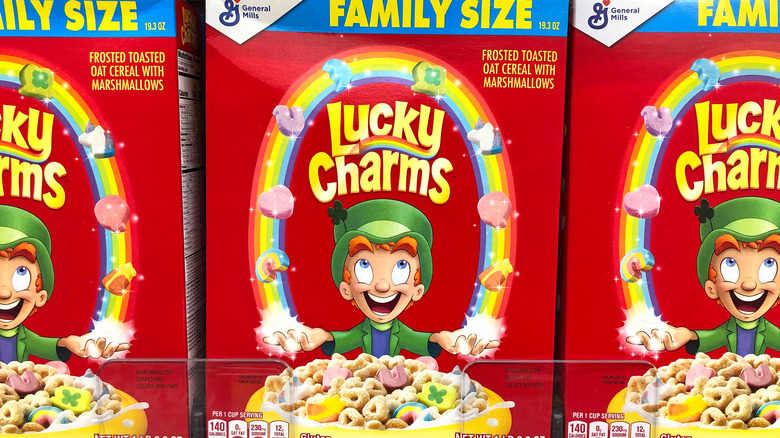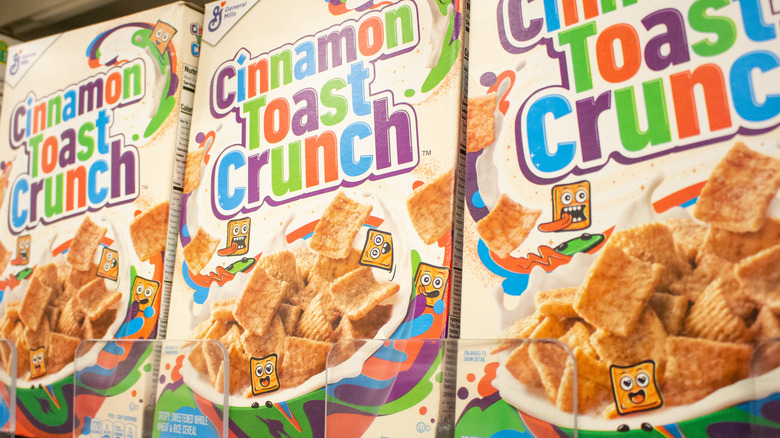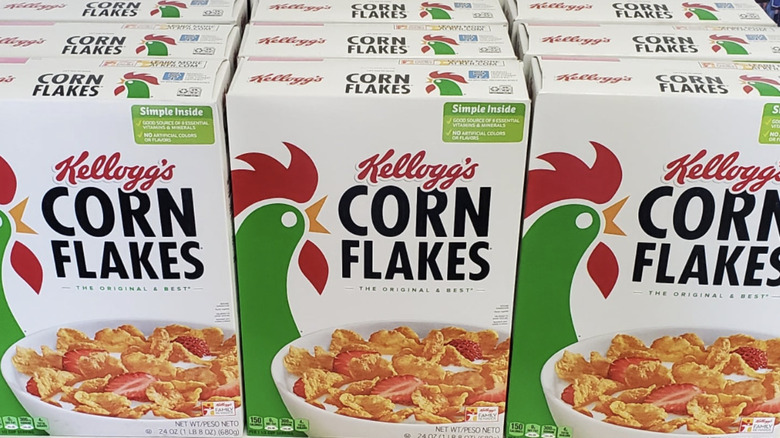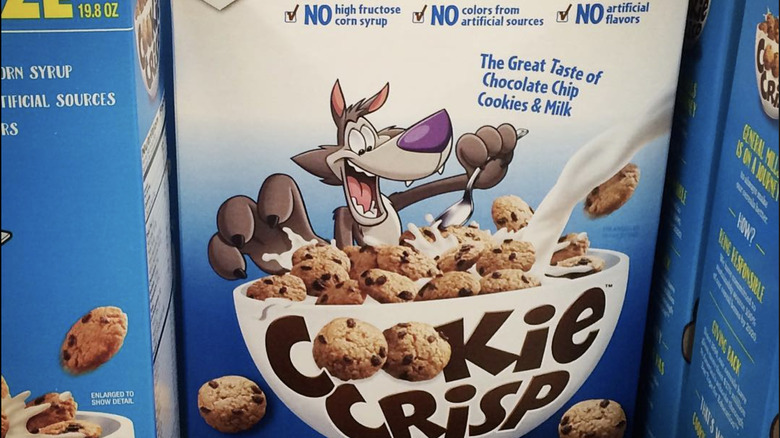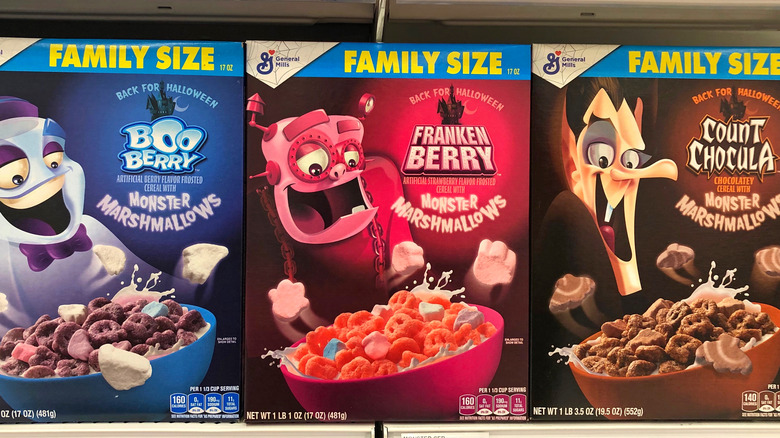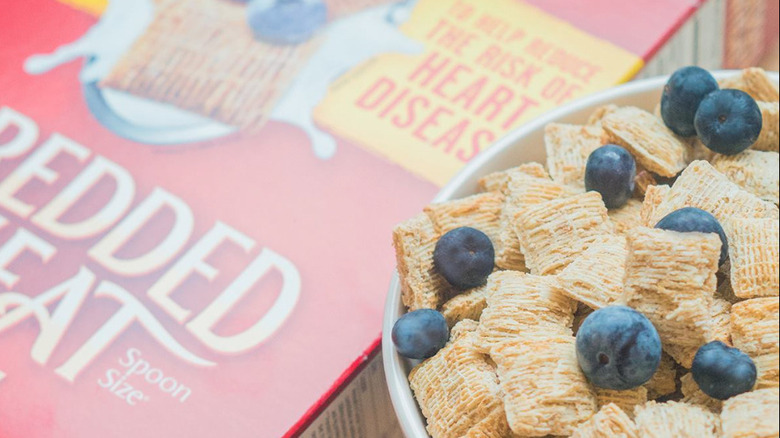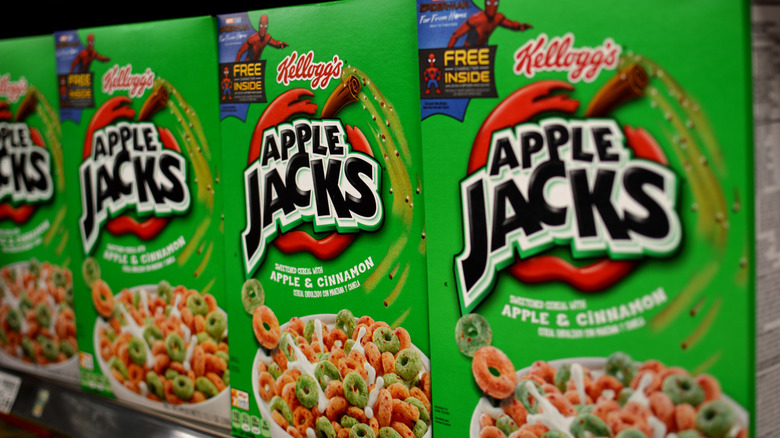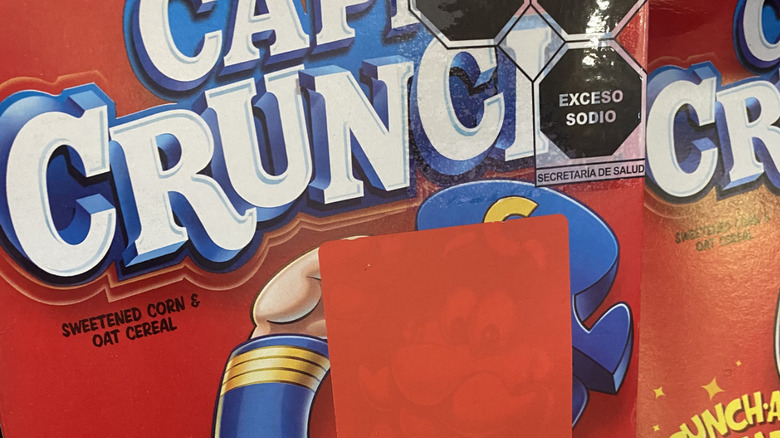Cereals That Are Banned In Other Countries
America in the 20th century brought us some weird food trends. In addition to strange incarnations like aspic and the polarizing presence of Spam, there was also an insatiable need to dye much of what we ate unnatural colors — especially food marketed toward kids, like breakfast cereal. To top it all off, much of what Americans eat — including cereal — is pumped so full of preservatives that it could probably be consumed sometime in the next millennium.
Come to find out, the proclivity in the U.S. to make children's cereal rainbow-colored is not just frowned upon in other parts of the world — it's banned. And those preservatives? Countries like Norway, Japan, England, and the whole E.U. have completely outlawed the use of certain manmade chemicals in food because they've been linked to some serious health problems.
For this reason, there are some cereals that are popular in America that will never see the inside of a store in certain nations. Cereals like Frosted Flakes and Rice Krispies are widely believed to be banned in other countries due to the preservatives they contain, but as it would happen, cereal heavyweights like Kellogg's actually go so far as to remove the harmful preservatives from the food they sell internationally but continue to add them to the U.S. versions. Want to know if your favorite cereal has been banned overseas? Here's our list of cereals that have been met with controversy on foreign turf.
Other countries aren't too sweet on Honey Bunches of Oats
Compared to other standbys in the cereal aisle, Honey Bunches of Oats from Post is a relatively new addition but has become one of the brand's top sellers. Vernon J. Herzing was working for Post when he created this sweet and nutty cereal by combining a variety of existing cereals. After spending three years in the developing stage, Herzing's creation was named Honey Bunches of Oats and hit stores in 1989, but you won't see it for sale in just any country.
Honey Bunches of Oats wasn't just marketed to kids, but to the entire family. And judging by its ingredients, which include grains, granola, and an almond variety, it seems like a healthy enough breakfast choice. That is until you take a look at the ingredients. Like many processed foods, the list of ingredients starts off with what you'd expect (corn, whole grain wheat, sugar, and rolled oats in this case), but read on, and you'll start to see items that are a little puzzling. One such ingredient is BHT — short for butylated hydroxytoluene — followed by the words "added to preserve freshness." It seems harmless enough — unless you live in a country where consuming the preservative BHT is highly restricted by law. The E.U., United Kingdom, Norway, Canada, Australia, New Zealand, and Japan have given a collective thumbs down to this carcinogen because eating it has been known to cause tumors in the body and hinder blood clotting.
There are s'more preservatives in Honey Maid S'mores
Post continues to make cereals that will never see the inside of many international grocery stores due to other nations' stance against BHT in food. Honey Maid S'mores cereal, a decadent flavor punch inspired by the timeless campfire treat, was introduced in 2017. Yes, it was modeled after actual s'mores, but it looks more like a mix of Golden Grahams and Cocoa Puffs with some kernels of marshmallow thrown in. The cereal was initially sold as a Walmart exclusive, which was fitting because discount superstores and chemical-laden processed foods are — for better or worse — quintessentially American.
Check out a box of Honey Maid S'mores cereal, and you'll see BHT among the ingredients. Is BHT really so bad? Studies show that BHT (and its sister component BHA, butylated hydroxyanisole) is a corrosive additive that harms the liver, kidneys, and lungs over time and can irritate skin. In the 1990s, scientific studies on BHT gained ground in Europe and other parts of the world, eventually leading many countries to prohibit its widespread use in common food items like potato chips, chewing gum, and breakfast cereals. Seeing that Honey Maid S'mores is a new creation and hasn't reached the heritage status of other cereals like Rice Krispies or Frosted Flakes, Post does not modify the recipe in order for it to be sold on an international scale. To put it simply, countries that restrict BHT don't sell Honey Maid S'mores.
Blue Froot Loops are out of the loop outside the U.S.
Kellog's Froot Loops have had a place at the breakfast table since 1963, but they weren't always so vibrant. Froot Loops originally came in just three colors: red, orange, and yellow. This remained the case for decades — until the '90s. Popular '90s foods aimed at children were often saturated with bright dyes in order to make them look more fun to eat. Kellogg's jumped on the trend and brought blue and green loops into the mix. American Froot Loops rely on red No. 40, yellow No. 5, yellow No. 6, and blue No. 1 to achieve such eye-popping color. There is also some BHT thrown in for freshness.
Nations like Australia, New Zealand, England, and the E.U. sell Froot Loops but in addition to nixing the BHT, they leave out all that '90s-era food coloring, which has a scientific reputation for its link to allergies and hyperactivity in kids. Europe, Australia, and New Zealand permit the limited use of the food dyes found in Froot Loops as long as the packaging comes with a warning label; they just prefer their Froot Loops with more natural flavors. To accomplish this, Froot Loops in Australia and New Zealand contain ingredients like paprika extract, orange, lemon, and lime. In Europe, currant, radish, cherries, and carrot are used. Due to the lack of a natural-looking blue alternative, these countries prefer to omit blue Froot Loops altogether instead of using blue No. 1.
Japan turns down Lucky Charms' pot of gold
As we mentioned, many countries permit small quantities of artificial food dyes as long as there's a label on the front of the food package that warns of their potentially adverse effects. Well, Japan sees things a little differently. It is the only country in the world that bans the use of yellow No. 6 as an additive in food. That spells trouble for quite a few cereals, most notably, Lucky Charms.
The sweetened oat cereal with bits of pastel-colored marshmallows in whimsical shapes has been made by General Mills since 1964. Not only was Lucky Charms the first cereal to use marshmallows, but it's also one of the best-selling cereals in the United States, with annual sales of around $283.4 million, according to Zippia.
That being said, much of Lucky Charms' popularity has to do with its marshmallow pieces and children's fondness for eating rainbows, pots of gold, and shamrock hats that turned the milk the color of an Easter egg at the end (thanks for the memories red No. 40, blue No. 1, yellow No. 5, and yellow No. 6). Cereal is not as popular of a breakfast choice in Japan as it is in the U.S. so rather than modify the ingredients to suit Japanese standards, General Mills just does not sell it there at all. Silver lining? Lucky Charms does not contain BHT.
Cinnamon Toast Crunch's European makeover
A box of Cinnamon Toast Crunch in the pantry was a welcome sight in our younger years, and to be honest, the cereal still tastes pretty good. The sweet squares swirled with cinnamon and dusted with sugar have been sold since 1984 and were originally proffered by Chef Wendell, an elderly, bespectacled baker with a toothy smile. We're not accusing the cereal mascot of putting BHT in Cinnamon Toast Crunch though. Nope, that was the decision of General Mills.
Chef Wendell retired in 2009 and was replaced by The Crazy Squares, but the ingredient list was less susceptible to change. Every box produced for the U.S. market still contains BHT "to preserve freshness". General Mills was fully aware that BHT's inclusion in Cinnamon Toast Crunch prohibited its sale on most foreign grocery store shelves, so it pulled a few sneaky strings. Unwilling to sacrifice cereal sales due to unlawful ingredients, General Mills skipped the BHT, slapped a Nestlé label on the box (General Mills and Nestlé happen to be a joint business venture), and renamed Cinnamon Toast Crunch as Cini Minis. If it weren't for the crazy eyes of The Crazy Squares staring at us from the front of the box, it would not be immediately clear it was the same cereal. In some ways, it isn't the same. We're not sure if it's the absence of BHT, but some consumers report that cini minis "taste like s*** in comparison" (via Reddit).
Corn Flakes and its mascot are unwelcome abroad
Corn Flakes is the grandaddy of cold cereal. It was created in 1906 and is the original Kellogg's product. Since it goes so far back and looks plain, Corn Flakes often gets labeled as one of the healthier cereals, but in reality, it has endured numerous controversies, including being banned in other countries.
In 2004, Corn Flakes and Special K were banned in Denmark for containing high levels of vitamin fortification that could damage the kidney and liver functions of children if they ate the cereal regularly. Kellogg's ended up tweaking the ingredients so the cereal could be sold throughout Europe, while the heavily vitamin-enriched version continued to sell in America. More recently, Mexican authorities seized hundreds of thousands of Corn Flakes boxes in conjunction with a new law banning cartoon mascots from peddling overly sugary food to impressionable kids. The first Latin American country to pass the anti-mascot law was Chile, and in 2018 Mexico followed suit. Of all the mascots to be banned for influencing children, it's a little surprising that the Corn Flakes rooster was targeted — it doesn't even talk! The rooster, (whose name is Cornelius, obviously) lacks the wild-eyed, chatter-box attributes of other cereal mascots, but the fact that it's an animation signaling consumers to start their morning off right with a bowl of Corn Flakes — which have 4 grams of added sugar and 300 milligrams of sodium per serving — is misleading in the eyes of some lawmakers.
Cookie Crisp's Vitamin C content isn't cool with Canada
Vitamin fortification in cereal seems like it might be a good thing, right? Not necessarily. Tons of cereals are fortified with vitamins and minerals to help consumers meet the recommended daily values and avoid deficiencies. Some of the most common fortifications found in American cereals are iron, calcium, various B vitamins, vitamin A, and vitamin D. However, fortified cereals are typically high in sugar and extremely processed. This is certainly the case with General Mills' Cookie Crisp, but it isn't the sugar content that caused this cereal to be banned in Canada. It's the vitamin C fortification.
Browse the nutritional information on a Cookie Crisp box in the U.S., and you'll see a lot of the usual suspects in the vitamins and minerals section. There are iron and zinc, A and B vitamins like folic acid and riboflavin, as well as vitamin C (sodium ascorbate). According to the official Food and Drug Relations guidelines in Canada, breakfast cereal can only be fortified with specific vitamins and minerals, and vitamin C did not make this list. Yet again, General Mills went the Nestlé route in Europe and sells a version of Cookie Crisp without Vitamin C. Meanwhile, the only cereal Nestlé Canda sells is the Gerber baby variety. Canadians who insist on having cookies for breakfast aren't totally without options. In 2017, (40 years after Cookie Crisp's release), Post debuted Chips Ahoy! Cereal, and it is available in Canada.
Count Chocula and its companion cereals are strictly seasonal for Canadians
O Canada! You banished Count Chocula and his ghoulish friends too? For your average American kid, Count Chocula cereal is nothing short of a delicacy. It's sort of the all-chocolate, haunted version of Lucky Charms. If for some reason spooktacular chocolatey cereal isn't your thing, there are two berry-flavored alternatives: Boo Berry and Franken Berry. That is, of course, as long as you don't reside in Canada. If you do, you'll have to hope you can find some come Halloween season.
Unlike other cereals on our list, Count Chocula isn't pretending to be healthy when it isn't — it's just another sugar bomb enticing children in the cereal aisle. The Environmental Working Group (EWG), which analyzes thousands of processed foods, rates Count Chocula a 7 out of 10 on its scale of concern (with 10 being the worst score). That's better than other cereals can say (Froot Loops scored a 9), but Canada is reluctant to give the Count, Boo Berry, or Franken Berry a full green light. Even in October, these cereals are not easy to come by. When Canadian stores do offer them, they tend to sell out fast. As much as we love Count Chocula, we have to agree with the EWG. Despite the cereal being almost completely brown, General Mills still managed to add every food dye. Red No. 40, blue No. 1, yellow No. 5, and yellow No. 6 are all present.
Post Shredded Wheat proves looks can be deceiving
Remember what we said about certain cereals disguising themselves as healthy? Post Shredded Wheat is a perfect example. At a glance, most shoppers look at this box and assume that its unsweet, natural-colored simplicity means that it has some kind of nutritional benefit. Phrases on the box such as "9 out of 10 doctors recommend" and "excellent source of fiber" help to play up Shredded Wheat's healthiness. No, these aren't lies, but they are slight diversion tactics. Turn that box to the side, and you'll see just two ingredients: whole-grain wheat and BHT.
It's baffling why Post would insist on using BHT in such a basic cereal. Post Shredded Wheat is not sold in many other countries even though this type of cereal is popular all over the world. On its website, Post states that its cereals are distributed in Canada, Mexico, Central and South America, Asia, the Caribbean, and the Middle East. The most glaring omission from this list is Europe. As we've seen, other cereal conglomerates like Kellogg's and General Mills go the extra mile to omit unnatural vitamin fortifications, questionable preservatives, and synthetic food coloring in order to continue doing business in Europe. If you buy a box of Post Shredded Wheat in Canada, it will contain BHT. Kellogg's also favors the preservative powers of BHT, but General Mills is starting to step away from it, preferring to use vitamin E instead.
Apple Jacks relies on outlawed dyes
Judging by its name, Apple Jacks seems like it would be brimming with rustic apple flavor, but that isn't really the case with this cereal. Apple Jacks has been around since 1965 but right from the start, Kellogg's has not appeared to prioritize actual fruit flavors or colors. Rather, it is known for its bright green and orange O's that look anything but natural. Like its rainbow-hued cousin Froot Loops, Apple Jacks draws its vibrancy from the big four manufactured dyes: red No. 40, blue No. 1, yellow No. 5, and yellow No. 6.
The inclusion of yellow No. 6 means that Apple Jacks is a no-go in Japan. Breakfast cereal culture is much less prevalent in Japan than it is in the U.S. or Europe, which likely gives Kellogg's little to no incentive to revise the color additives used in Apple Jacks. It appears that Apple Jacks is not too popular in foreign countries to begin with, so being banned in Japan might not be that big of a blow. Kellogg's websites for the U.K., Denmark, Norway, Germany, and Australia all sell a slightly different selection of the brand's signature cereals, but Apple Jacks is not included among any of them — which is interesting because even the American version is BHT free.
Some countries have canceled Cap'n Crunch
Cap'n Crunch is one of those emblematic American cereals that many people recognize. Quaker introduced the Cap'n and his crunchy, sweetened corn and oat cereal to the masses in 1963 and has seemingly never lost momentum — in the United States at least. These days, Cap'n Crunch's ingredient list reads like a cautionary tale. Even without the crunch berries, the cereal still contains BHT and yellow No. 5 and yellow No. 6. Factoring in the crunch berries means that red No. 40 and blue No. 1 also join the chemical party. Based on these ingredients, Cap'n Crunch's influence has not reached European shores, but once Chile and Mexico agreed to collectively ban all junk food mascots, the Cap'n was ousted, and the cereal box was plastered with stickers warning of its excess calories, sodium, and sugar.
It's a little strange to see the once friendly Cap'n's face obscured by colored tape in Mexico and Chile as if he is some kind of dirty secret. But at the same time, perhaps these troubling nutritional trends have plagued breakfast cereals for far too long.
